Calculate Out-The-Door Price
close
When the super smart engineers designed and built your car, they crunched some numbers and determined exactly how much weight it could carry safely based on the right tire size and pressure. This is what we call the “tire load index.” The tires that come on your vehicle will have the proper load index, so stick to that number or higher when you purchase new tires. You can also check the vehicle’s manual to find the recommended tire size and load rating.
The tire load index tells you how much weight your tire can carry, and overloading your tires is never a good idea! When you put too much weight on your tires, you can cause damage and wear them down prematurely. Even worse, you run the risk of experiencing a tire blowout. Imagine trying to carry a box full of cement blocks. Just like your legs would buckle under the weight, your tires can completely give out if they’re overloaded.
The tire load index lets you know the load carrying capacity of a tire. In other words, it’s the amount of weight your tire can support safely.
For example, if a tire has a load index of 92, it can support 1,389 pounds at maximum air pressure. Multiply that by four tires (4 x 1,389 = 5,556 pounds) to get your car’s maximum load carrying capacity. Never install tires with a lower load carrying capacity than the original tires that were factory installed on your vehicle.
| Load- Carrying Capacity Index Ratings | |||||
|---|---|---|---|---|---|
| Load Index | Load (lbs) | Load Index | Load (lbs) | Load Index | Load (lbs) |
| 0 | 99 | 50 | 419 | 100 | 1764 |
| 1 | 102 | 51 | 430 | 101 | 1819 |
| 2 | 105 | 52 | 441 | 102 | 1874 |
| 3 | 107 | 53 | 454 | 103 | 1929 |
| 4 | 110 | 54 | 467 | 104 | 1984 |
| 5 | 114 | 55 | 481 | 105 | 2039 |
| 6 | 117 | 56 | 494 | 106 | 2094 |
| 7 | 120 | 57 | 507 | 107 | 2149 |
| 8 | 123 | 58 | 520 | 108 | 2205 |
| 9 | 128 | 59 | 536 | 109 | 2271 |
| 10 | 132 | 60 | 551 | 110 | 2337 |
| 11 | 136 | 61 | 567 | 111 | 2403 |
| 12 | 139 | 62 | 584 | 112 | 2469 |
| 13 | 143 | 63 | 600 | 113 | 2535 |
| 14 | 148 | 64 | 617 | 114 | 2601 |
| 15 | 152 | 65 | 639 | 115 | 2679 |
| 16 | 157 | 66 | 639 | 116 | 2756 |
| 17 | 161 | 67 | 677 | 117 | 2833 |
| 18 | 165 | 68 | 694 | 118 | 2910 |
| 19 | 171 | 69 | 716 | 119 | 2998 |
| 20 | 176 | 70 | 739 | 120 | 3086 |
| 21 | 182 | 71 | 761 | 121 | 3197 |
| 22 | 187 | 72 | 783 | 122 | 3307 |
| 23 | 193 | 73 | 805 | 123 | 3417 |
| 24 | 198 | 74 | 827 | 124 | 3527 |
| 25 | 204 | 75 | 852 | 125 | 3638 |
| 26 | 209 | 76 | 882 | 126 | 3748 |
| 27 | 215 | 77 | 908 | 127 | 3858 |
| 28 | 220 | 78 | 937 | 128 | 3968 |
| 29 | 227 | 79 | 963 | 129 | 4079 |
| 30 | 234 | 80 | 992 | 130 | 4189 |
| 31 | 240 | 81 | 1019 | 131 | 4289 |
| 32 | 247 | 82 | 1047 | 132 | 4409 |
| 33 | 254 | 83 | 1074 | 133 | 4541 |
| 34 | 260 | 84 | 1102 | 134 | 4674 |
| 35 | 267 | 85 | 1135 | 135 | 4806 |
| 36 | 276 | 86 | 1168 | 136 | 4938 |
| 37 | 282 | 87 | 1201 | 137 | 5071 |
| 38 | 291 | 88 | 1235 | 138 | 5203 |
| 39 | 300 | 89 | 1279 | 139 | 5357 |
| 40 | 309 | 90 | 1323 | 140 | 5512 |
| 41 | 320 | 91 | 1356 | 141 | 5677 |
| 42 | 331 | 92 | 1389 | 142 | 5842 |
| 43 | 342 | 93 | 1433 | 143 | 6008 |
| 44 | 353 | 94 | 1477 | 144 | 6173 |
| 45 | 364 | 95 | 1521 | 145 | 6393 |
| 46 | 375 | 96 | 1565 | 146 | 6614 |
| 47 | 386 | 97 | 1609 | 147 | 6779 |
| 48 | 397 | 98 | 1653 | 148 | 6844 |
| 49 | 408 | 99 | 1709 | 149 | 7165 |
| 150 | 7385 | ||||
As you can tell, the tire load index is massively important when you’re shopping for new tires. When it’s time to select new tires for your vehicle, you must select tires that can support your car’s Gross Vehicle Weight Rating (GVWR). This number can be found in the owner’s manual. To determine if a set of tires will work on your particular car, use the tire load index chart to see how many pounds each tire can support. Multiply that by four (since your vehicle will use four tires). As long as that number is greater than the GVWR of your vehicle, those tires should work. If you think that sounds like a lot of math, don’t worry. Sit back, relax, and let the expert of Tires Plus do the hard work for you. Schedule your appointment for brand new tires today!
When it’s time to select new tires for your vehicle, you must select tires that can support your car’s Gross Vehicle Weight Rating (GVWR). This number can be found in the owner’s manual. To determine if a set of tires will work on your particular car, use the tire load index chart to see how many pounds each tire can support. Multiply that by four (since your vehicle will use four tires). As long as that number is greater than the GVWR of your vehicle, those tires should work. If you think that sounds like a lot of math, don’t worry. Sit back, relax, and let the expert of Tires Plus do the hard work for you. Schedule your appointment for brand new tires today!
{{storeNumber}}
{{storeName}}
{{link-icon "Call Us" mobileCallLink null "call-cta"}} {{link-icon "Directions" directions "_blank" "directions-cta"}}
{{address}}
{{city}}, {{state}} {{zip}}
{{#if activeFlag}} {{#ifCond mystore "or" myPreferredStore}} {{#ifCond storeType 'eq' "TPL"}}
*Call store for appointment {{phone}}
{{else}} {{#if onlineAppointmentActiveFlag }}
{{#if myPreferredStore}}
{{else}}
*Call store for appointment {{phone}}
{{/if}} {{/ifCond}} {{else}} {{#ifCond storeType 'eq' "TPL"}}
*Call store for appointment {{phone}}
{{else}}
Schedule Appointment {{#if onlineAppointmentActiveFlag}} {{else}}
*Call store for appointment {{phone}}
{{/if}}
{{/ifCond}} {{/ifCond}} {{else}}
*Temporarily Closed Due To: {{temporarilyClosedReason}}
{{/if}} {{#if isMilitaryStore}}
*This location is on an active US military base. You may need military ID to access the location.
You may need military ID to access the location.
{{/if}}
{{#ifCond count 'eq' "3"}} Show More Stores {{/ifCond}}
A tire’s load index is a number that can be used to look up the maximum amount of weight a tire can bear at its speed rating when inflated to its maximum PSI.
This number, which is usually between 75 and 100 for passenger cars, is not stated in pounds or any other unit of measurement.
It is used to find the actual rated value in pounds on a standardized chart.
The load index is the second-to-last component of the seven-part tire size code molded into the sidewall of your tire. It is a two or three digit number that precedes the tire speed index letter at the very end of the code.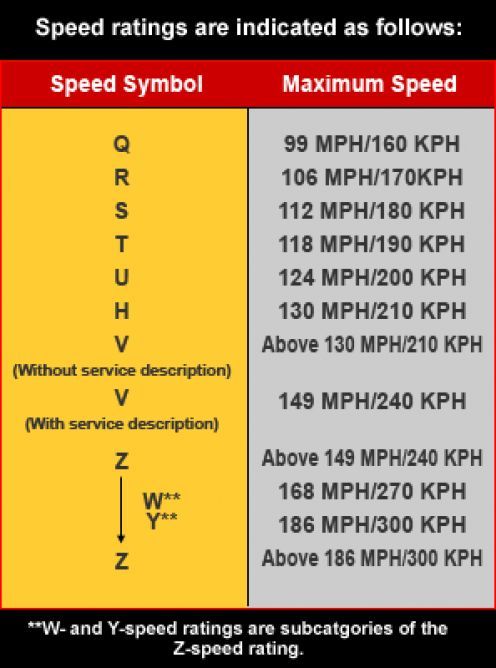
In the example size code in the image, the load index is 96. You can find the load index on your tire, and then use this chart to find the maximum weight each tire can withstand:
Each load index number is tied to a real weight, measured in pounds, on the chart. A tire with a load index of 96, for example, is rated to hold 1565 pounds at max PSI and at its rated speed.
| Load Index | Load (lbs) |
|---|---|
| 75 | 852 |
| 76 | 882 |
| 77 | 908 |
| 78 | 937 |
| 79 | 963 |
| 80 | 992 |
| 81 | 1019 |
| 82 | 1047 |
| 83 | 1074 |
| 84 | 1102 |
| 85 | 1135 |
| 86 | 1168 |
| 87 | 1201 |
| 88 | 1235 |
| 89 | 1279 |
| 90 | 1323 |
| 91 | 1356 |
| 92 | 1389 |
| 93 | 1433 |
| 94 | 1477 |
| 95 | 1521 |
| 96 | 1565 |
| 97 | 1609 |
| 98 | 1653 |
| 99 | 1709 |
| 100 | 1764 |
| Load Index | Load (lbs) |
|---|---|
| 101 | 1819 |
| 102 | 1874 |
| 103 | 1929 |
| 104 | 1984 |
| 105 | 2039 |
| 106 | 2094 |
| 107 | 2149 |
| 108 | 2205 |
| 109 | 2271 |
| 110 | 2337 |
| 111 | 2403 |
| 112 | 2469 |
| 113 | 2535 |
| 114 | 2601 |
| 115 | 2679 |
| 116 | 2756 |
| 117 | 2833 |
| 118 | 2910 |
| 119 | 2998 |
| 120 | 3086 |
| 121 | 3197 |
| 122 | 3307 |
| 123 | 3417 |
| 124 | 3527 |
| 125 | 3638 |
| Load Index | Load (lbs) |
|---|---|
| 126 | 3748 |
| 127 | 3858 |
| 128 | 3968 |
| 129 | 4079 |
| 130 | 4189 |
| 131 | 4289 |
| 132 | 4409 |
| 133 | 4541 |
| 134 | 4674 |
| 135 | 4806 |
| 136 | 4938 |
| 137 | 5071 |
| 138 | 5203 |
| 139 | 5357 |
| 140 | 5512 |
| 141 | 5677 |
| 142 | 5842 |
| 143 | 6008 |
| 144 | 6173 |
| 145 | 6393 |
| 146 | 6614 |
| 147 | 6779 |
| 148 | 6844 |
| 149 | 7165 |
| 150 | 7385 |
The load index is something you should pay attention to because overloading your tires can damage them and cause them to wear out quickly.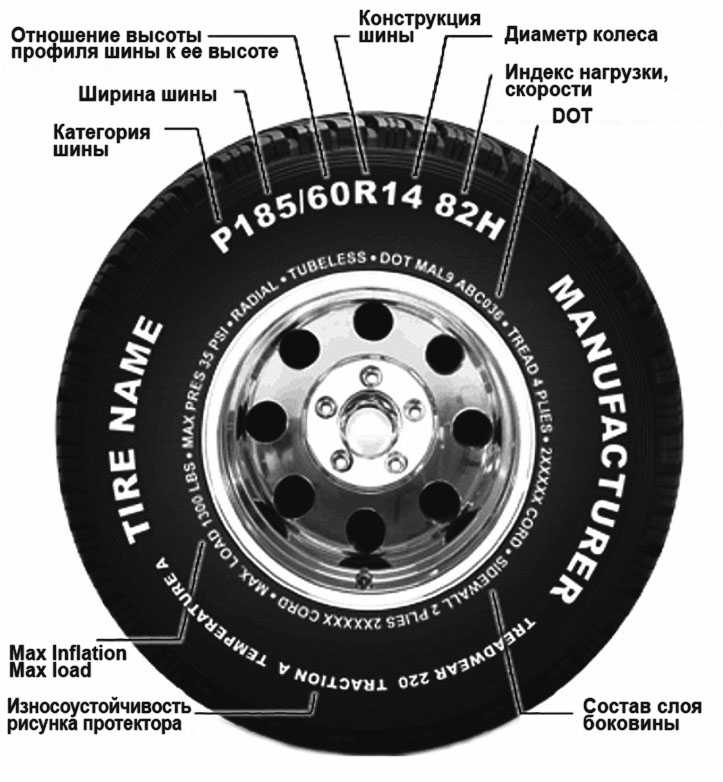 In more severe cases, excess weight on a tire could lead to life-threatening blowouts. Your car’s manufacturer states the recommended load index for your tires on the placard on the doorjamb on the driver’s side.
In more severe cases, excess weight on a tire could lead to life-threatening blowouts. Your car’s manufacturer states the recommended load index for your tires on the placard on the doorjamb on the driver’s side.
The load index and speed index appear together at the end of the tire size code. The easiest way to tell the difference between the two is that the load index is a two or three digit number, while the speed index is a single letter. In the example above, the load index is 97, while the speed index is V.
The load index on light truck tires is different from that of passenger cars: it usually has two ratings separated by a slash. This is because most light truck tires are designed to be used in a dual back wheel system with two tires side by side. The first number is the load rating when the tire is used alone, and the second is the rating when it is used as a dual tire.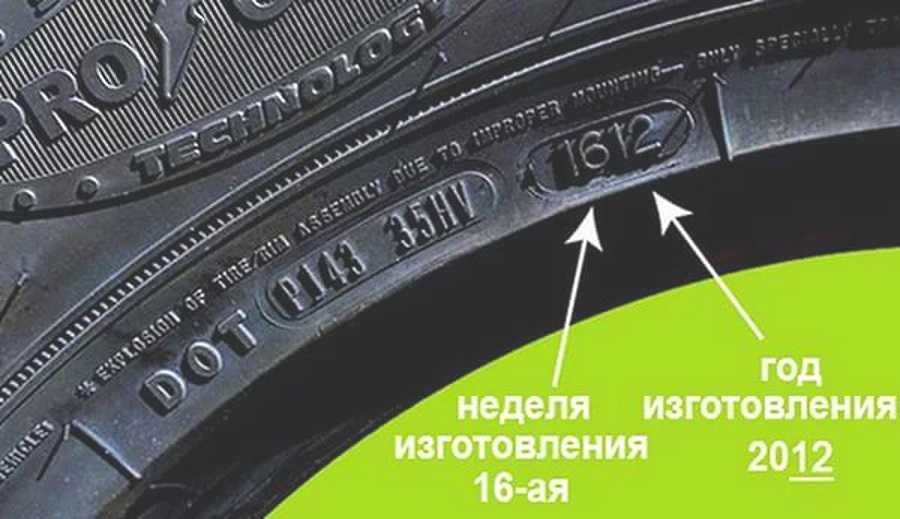 The dual rating is usually lower to cover situations where one tire in the pair fails and the other has to carry the full load.
The dual rating is usually lower to cover situations where one tire in the pair fails and the other has to carry the full load.
Aside from the load index, your tire’s sidewall contains lots of other useful information about its size, safety, and performance. Here you can find full information about your tire code.
CAN I USE A HIGHER LOAD INDEX TIRE?
Using a load rating that is higher than the recommended one should not pose any problems for your vehicle. But you should never fit tires on your car that fall short of the recommended load index.
DOES LOAD INDEX AND SPEED RATING MATTER?
Though they may receive less attention than the height, width, and rim diameter in a tire’s size code, load index and speed rating are crucial. They affect the tire’s performance, durability, and safety. A tire that doesn’t meet load specifications could wear out quickly or lead to bad accidents.
DOES THE TIRE LOAD INDEX AFFECT RIDE QUALITY?
The tire load index is not directly correlated to ride quality.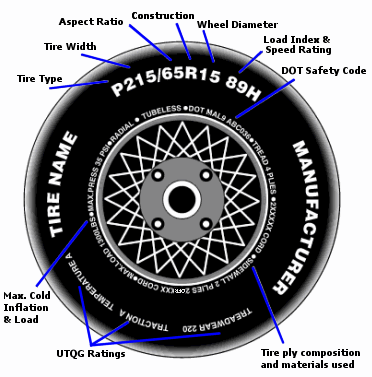 While major increases in load index will often mean taller, stiffer sidewalls and higher PSIs, and therefore a stiffer ride, there are many other factors such as suspension, tread, and correct inflation that have more noticeable effects on ride quality.
While major increases in load index will often mean taller, stiffer sidewalls and higher PSIs, and therefore a stiffer ride, there are many other factors such as suspension, tread, and correct inflation that have more noticeable effects on ride quality.
Now that you understand more about tire specs, you can browse Pirelli’s catalog to find tires for your size and weight requirements.
Search by car brand orsearch by tire size
01
Select your car brand
02
Select year
03
Select model
04
Select version
05
Select the result tailored for you
RELATED ARTICLES
Contents:
The selection of tires is carried out taking into account a number of parameters - their diameter, width, and profile height must be taken into account; in addition, the speed index and the load index are of no small importance. The manufacturer always indicates these indicators on the sidewall. What they mean will be discussed below.
The manufacturer always indicates these indicators on the sidewall. What they mean will be discussed below.
The value corresponds to the maximum permissible speed at which tires of this type can be operated. Accordingly, if a motorist plans to drive at a higher speed, it makes sense to think about buying tires with a higher index value.
| Index | K | L | M | N | P | Q | R | S | T | U | H | V | VR | W | Y | ZR |
Max.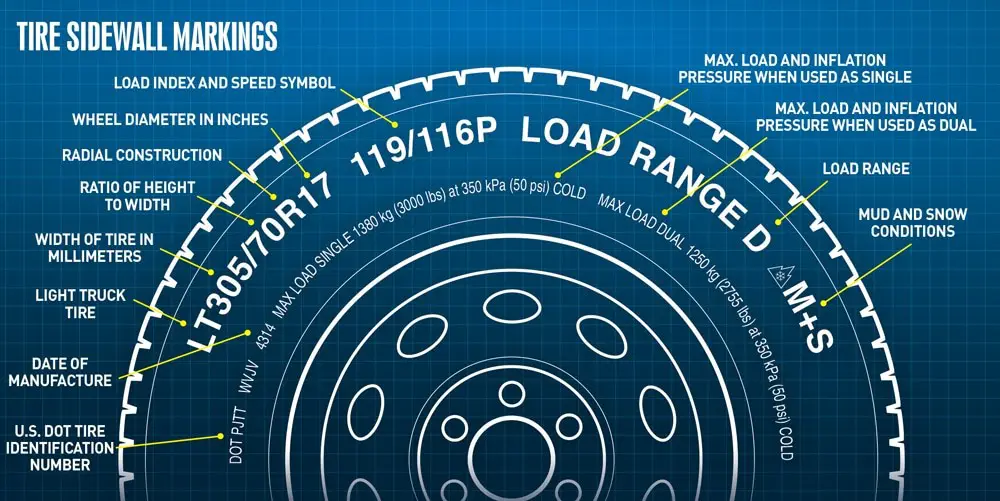 speed, km/h speed, km/h | 110 | 120 | 130 | 140 | 150 | 160 | 170 | 180 | 190 | 200 | 210 | 240 | >210 | 270 | 300 | >240 |
For example, if the tire has a mark that the speed index corresponds to the letter V, then this indicates that it is strongly not recommended to drive on these tires at a speed of more than 240 km / h.
This is a no less significant parameter, which, in contrast to the value discussed above, is indicated by a number. In the tire label, the load index factor follows the tire diameter.
For example, a value of 91 indicates that the maximum allowable load per tire cannot exceed 615 kg. Accordingly, the total load calculated on 4 wheels should not exceed 2460 kg. The complete load index table contains coefficient values from 1 to 279. For 13-inch passenger tires, the load index can be, for example, 75.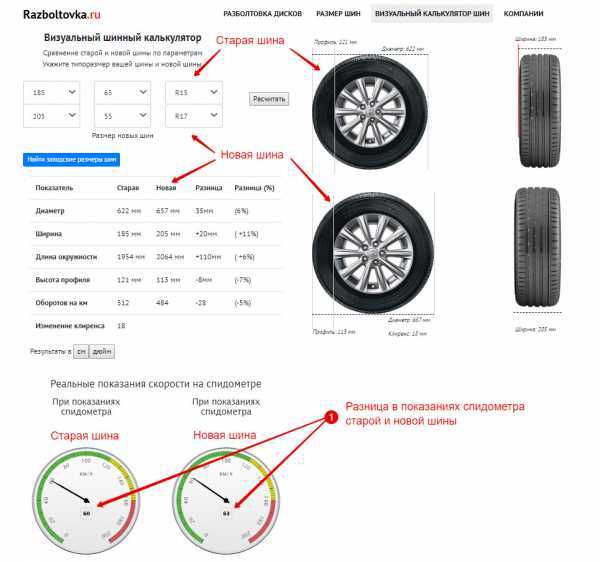 And for R20 wheels, this coefficient will reach 120.
And for R20 wheels, this coefficient will reach 120.
Load index table
Of course, the given load value does not mean that if it is exceeded, the tire will immediately be torn to pieces. A short-term excess of 20-30% is acceptable, but this should not become a habit.
According to EU regulations (ECE-R54), all tires that are planned to be used for commercial vehicles must be marked with a "Service Description" (translated as "Operating Conditions"). It is a special code next to the tire size, which carries information about the load index calculated for single and dual wheels (as an option - 102/100R).
The information must be recorded on both sidewalls of the tire. The 1st digit indicates the load capacity of the tire in the case of a single installation - the 2nd corresponds to the level of the maximum load on one tire with twin wheels. Additional markings are used to indicate the corresponding tire loads at higher speeds. Additional markings are always circled.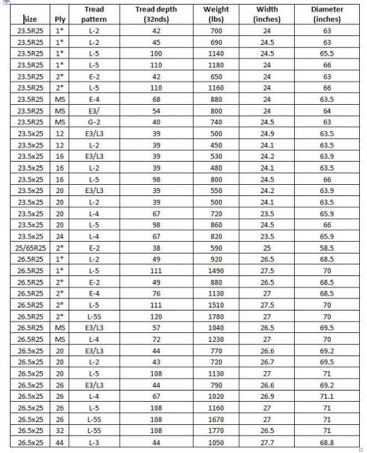
205 - the width of the tire profile, indicated in mm. In this case - 205 mm .
55 - the value of the height of the tire profile in%, determined from its width. In the situation under consideration - 55% of 205 mm will be equal to = 112.75 mm.
Given that the tire profile is a relative value, the following point must be taken into account when selecting rubber: if instead of size 205/55 R16 want to install tires with size 215/55 R16 , then not only the width of the tire will increase, but also its height! Such a situation is in most cases unacceptable (the only exception is the situation in which both sizes are given in the car's operating book). If this ratio is not given (as an option - 185 / R14С ), then this means that its value is 80-82%, and the tire is considered full profile. Reinforced tires with this marking are most often used on minibuses and light trucks - in these vehicles, the maximum allowable wheel load is of great importance.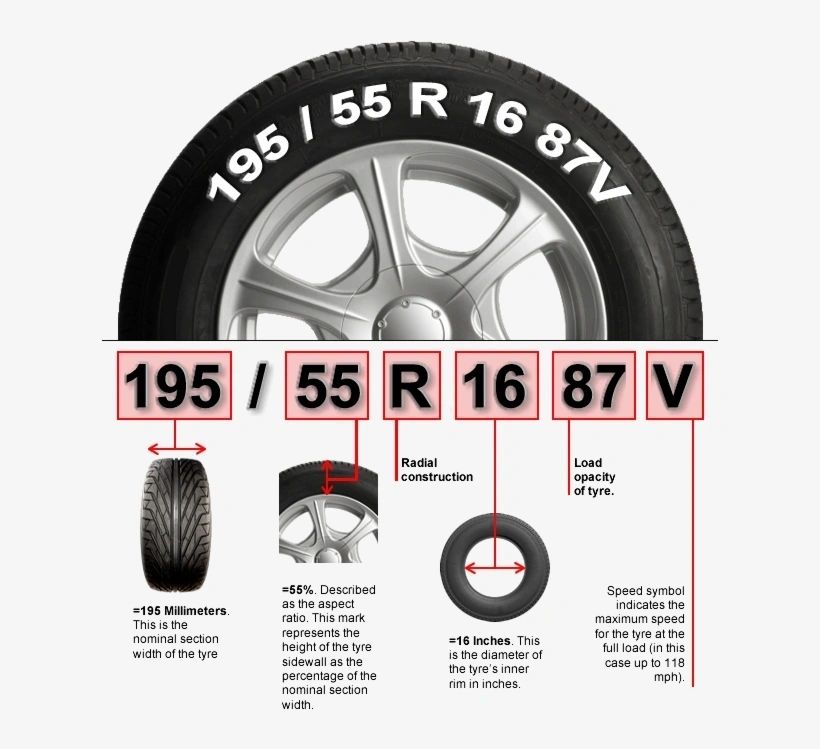
R - characterizes the design of the tire. In the situation under consideration, the tire is radial - the design determines the location of the carcass cord threads.
It is completely wrong to assume that the designation R indicates the radius of the tire. The symbol refers solely to its radial design. There is also a diagonal design (it corresponds to the letter D ), but today almost no one produces it. Reason: poor performance.
16 - the value of the diameter of the wheel (disk), indicated in inches. This diameter for the tire is internal, for the disk it is external. That is why it is called "landing".
94 - load index (it was already mentioned above). The interpretation of the most commonly used coefficients is given in the table of load indices. Often, the load is decoded on the tire itself: two numbers follow the Max Load inscription - the first in kg, the second in pounds.
H - tire speed index.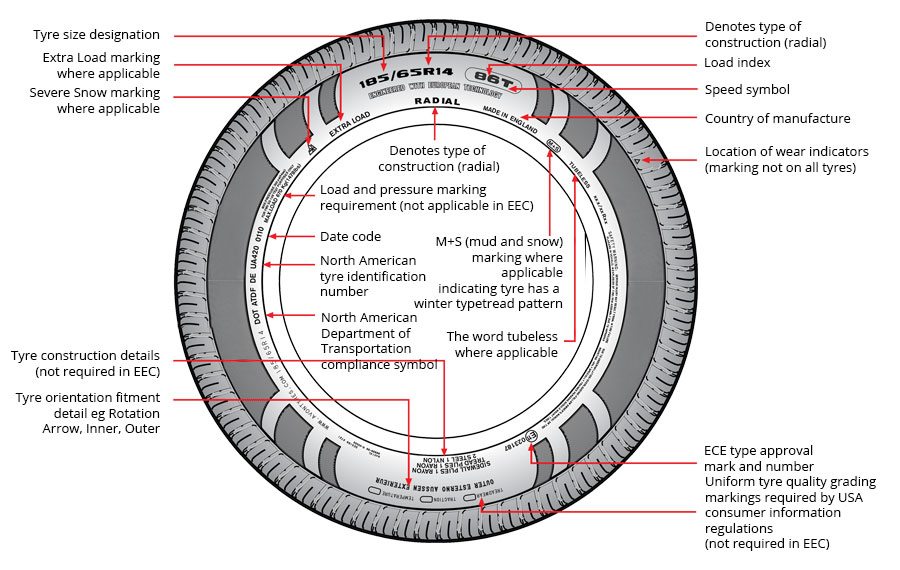 Please note that with this parameter, the tire manufacturer guarantees the normal operation of the rubber when the vehicle is driven non-stop at the specified speed for several hours. The decoding is given in the speed index table.
Please note that with this parameter, the tire manufacturer guarantees the normal operation of the rubber when the vehicle is driven non-stop at the specified speed for several hours. The decoding is given in the speed index table.
XL - this characteristic indicates that the tire is reinforced. Its load index is 3 units higher than conventional tires of the same size.
Separately, it is necessary to mention the RunFlat technology, which provides for the strengthening of the sides of the tire. As a result of damage, such a tire does not deflate and sag under the weight of the car, but allows you to drive a certain distance at a certain speed even after a complete loss of pressure. Those. The wheels are provided with additional protection. This quality is marked on tires in different ways - RSC, MOE, AOE - depending on the brand of car.
In addition to the above symbols in the form of letters and numbers, important information is indicated on the tires through colored labels. Below is an interpretation of each of them.
Below is an interpretation of each of them.
Apply in the lightest part of the tire. When installing a new tire on a rim, the yellow mark should be aligned with the heaviest part of the rim (easy to identify - it always corresponds to the nipple attachment point).
The label makes it possible to optimize the wheel balance and use lighter weights. On used tires, the yellow marking is no longer relevant - tire wear leads to a shift in its balance.
It has the appearance of a red dot on the tire and indicates the location of the maximum deviation of the radial force. At this point, the tire has the largest radius due to the greater number of layers and it is the most rigid. Inhomogeneity of tire plies is normal during tire manufacture.
The red dot on the tires during installation must match the white dot on the rims (note that both marks are placed on the original car tires).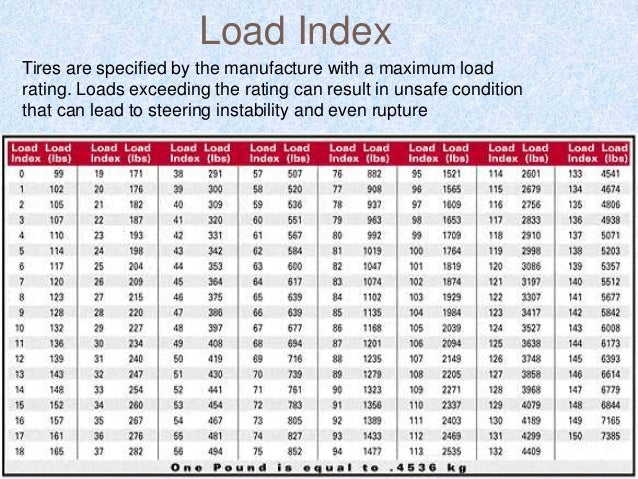 The white dots on the rims indicate the location closest to the center of the wheel. Alignment of the red dot on the tires and the white dot on the rims is recommended to reduce the effect of maximum heterogeneity in the tire. So it is possible to provide a better balance of the power characteristics of the wheel. In conventional tire fitting, one should not attach great importance to the red mark - it is better to focus on the yellow mark, combining it with the nipple.
The white dots on the rims indicate the location closest to the center of the wheel. Alignment of the red dot on the tires and the white dot on the rims is recommended to reduce the effect of maximum heterogeneity in the tire. So it is possible to provide a better balance of the power characteristics of the wheel. In conventional tire fitting, one should not attach great importance to the red mark - it is better to focus on the yellow mark, combining it with the nipple.
Corresponds to the individual number of the inspector conducting the final inspection of the tire at the manufacturing plant. The stamp can also be of other colors, this does not change the meaning of the label.
These designations are applied to the tire tread for easy identification of the tire in stock. For tires of all models and different sizes, this marking is different. There is no single unification of the application of colored stripes.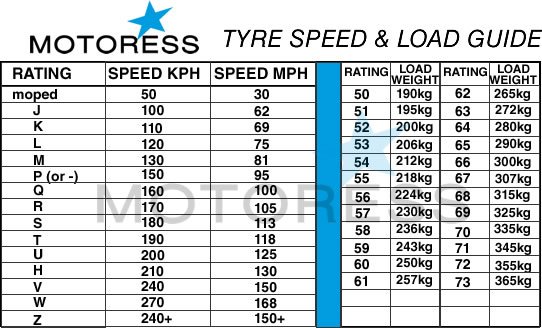 Details on the marking of certain colors on tires are prescribed in the manufacturer's specifications, and can also be indicated on its official website.
Details on the marking of certain colors on tires are prescribed in the manufacturer's specifications, and can also be indicated on its official website.
Colored stripes make it easy to identify the size and model of a single stack of tires stacked in a warehouse. The semantic load of color bars on the bus is unambiguous.
The letter C in the tire marking means that the tires are “reinforced” (added up to 8 reinforcing layers), with a large load factor.
The letter E, circled - compliance with European standards.
DA (stamped) - Minor manufacturing defects, which do not interfere with normal operation.
DOT - compliance with US quality standards.
M + S (mud and snow) - the designation indicates that the tires are all-weather. The designation AS and All seasons are interpreted in the same way.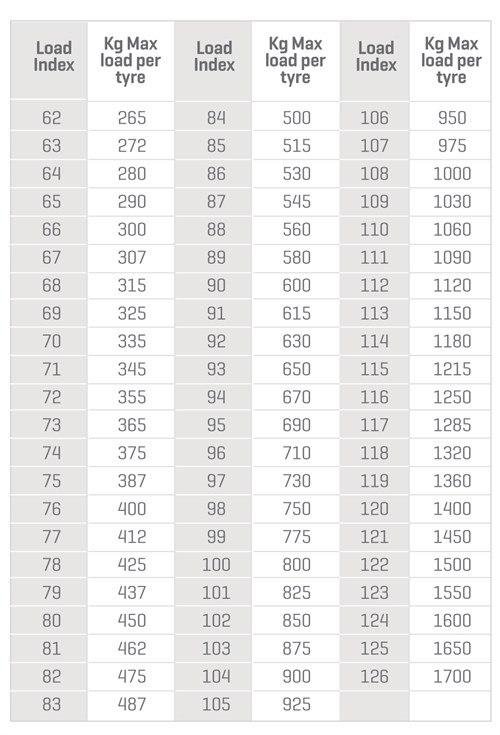
The snowflake design indicates that the rubber can be used in the most severe winter conditions. In its absence, the tire can only be used in the warm season and in the absence of a large amount of precipitation.
Made in Finland - country of origin.
MaxLoad - the maximum permissible load based on each wheel of the machine, in kg.
Max Pressure - the maximum allowable pressure level in the tire, in kPa.
Outside or Side Facing Out and Inside or Side Facing Inwards - indicates tire asymmetry. It is necessary to install with the Outside inscription outward, and the Inside inscription - inward.
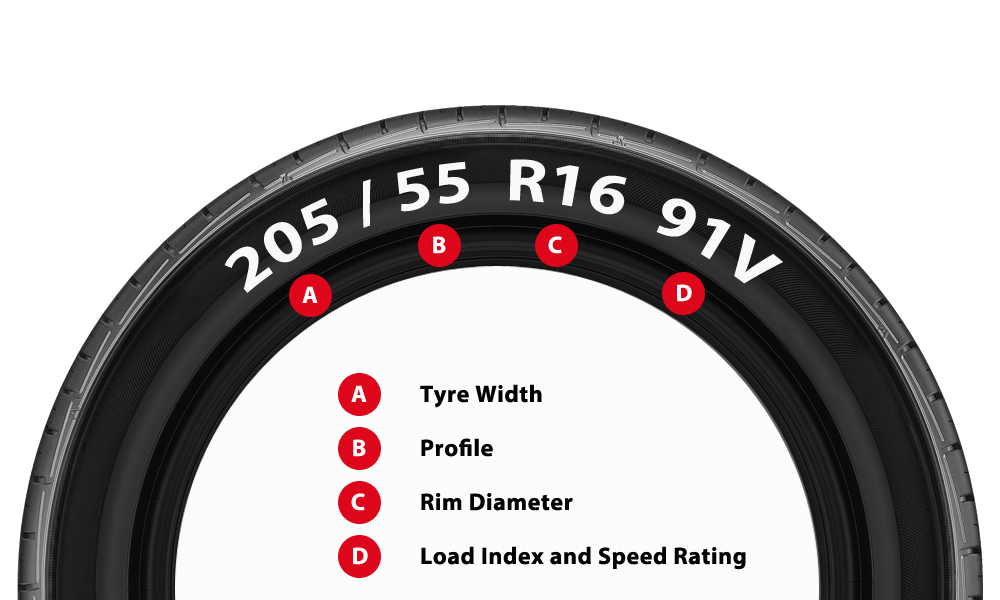 The distance that can be driven is determined by the manufacturer - the value varies from 50 to 150 km.
The distance that can be driven is determined by the manufacturer - the value varies from 50 to 150 km.
Sidewall - composition of the sidewall layer
Tubeless - tubeless tire. If this inscription is not present, then it is possible to use a tire only with a camera.
TubeType - indicates the possibility of operation with a camera only.
Steel - indicates the presence of a metal cord in the tire.

TWI - tread wear indicator specifications. The TWI marking can also be marked with an arrow. Pointers are distributed evenly in 8 or 6 places around the entire circumference of the tire. They indicate the lowest possible tread depth.
Umbrella image - indicates rain tires.
This characteristic is indicated in the form of 4 digits (as an option - 2516). Here, the first 25 is the week of manufacture, the last 16 is the year (so the tire was manufactured in June 2016).
What does SUV mean on tires How to store wheels on rims in the garage
Every car enthusiast wants new tires to last at least a couple of seasons - this is both convenient and profitable. However, increased loads on the tire can negate all efforts to keep the rubber in good condition for as long as possible. That is why, when choosing new tires, it is necessary to pay attention to such an indicator as the tire load index, the decoding of which contains important information for each driver. On the tire, it is applied next to the speed index and is indicated by numbers - for example, 98T (where 98 is the load index, T is the speed index).
However, increased loads on the tire can negate all efforts to keep the rubber in good condition for as long as possible. That is why, when choosing new tires, it is necessary to pay attention to such an indicator as the tire load index, the decoding of which contains important information for each driver. On the tire, it is applied next to the speed index and is indicated by numbers - for example, 98T (where 98 is the load index, T is the speed index).
The load index can be loosely referred to as the load carrying capacity of a tire - in other words, it is the load limit of a car equipped with specific tires at the maximum specified speed. The load indexes of passenger car tires range from 60 to 125 units (or from 250 to 1650 kg).
It is worth noting that a variety of indicators influence this parameter: the degree of tread wear, the tire temperature, and much more. To slightly smooth out the influence of these factors, the manufacturer always leaves a margin of safety of at least 20%.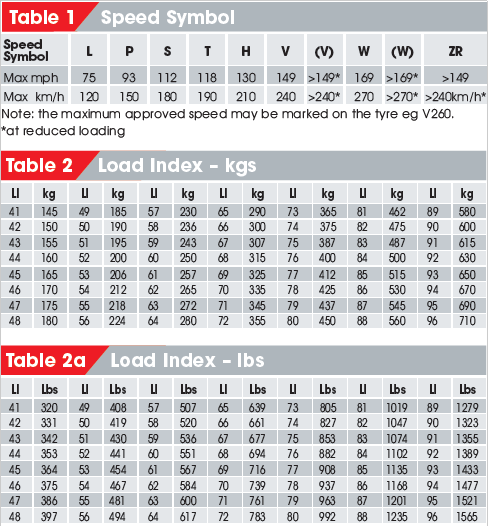
It is especially important to take into account the load index when moving on domestic roads - the wheel, once in the pit, must withstand the blow. If you do not pay attention to these parameters and load the car more than it is provided, then the likelihood that the tire will not withstand the load increases significantly.
Of course, such coefficients are always calculated with a margin, but it is better to save tire resources for some unforeseen event, and in normal operation it is better to save rubber. After all, tires whose load index is within the acceptable level last longer.
Consider a specific example - your tire is marked 98 T:
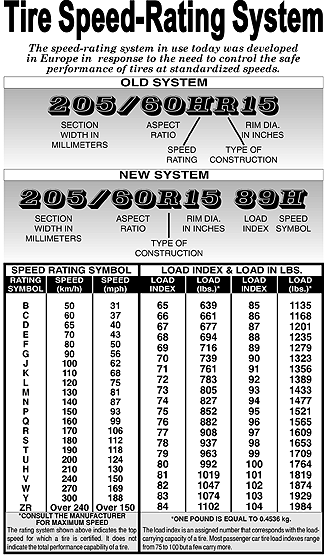 This is the load that your car will withstand at speed 190 km/h
This is the load that your car will withstand at speed 190 km/h However, the load index is the maximum allowable value, the top, which is not worth climbing. The weight of the car and load is not always evenly distributed between the front and rear axles, and passengers often sit in the wrong place for balance, and therefore there should always be a small margin. The most optimal and safe is the load in the amount of not more than 35% of the total mass of the car. In the end, for the transport of particularly heavy loads, you can always buy tires whose tire load index, the table of which is presented on our website, will be higher. But keep in mind that in this case, the load on the suspension will also increase, and this can lead to its premature wear.
In conclusion, we note another important nuance - the tire load index should not be less than that indicated on the tires in the basic configuration of the car. Failure to follow this rule may result in an accident.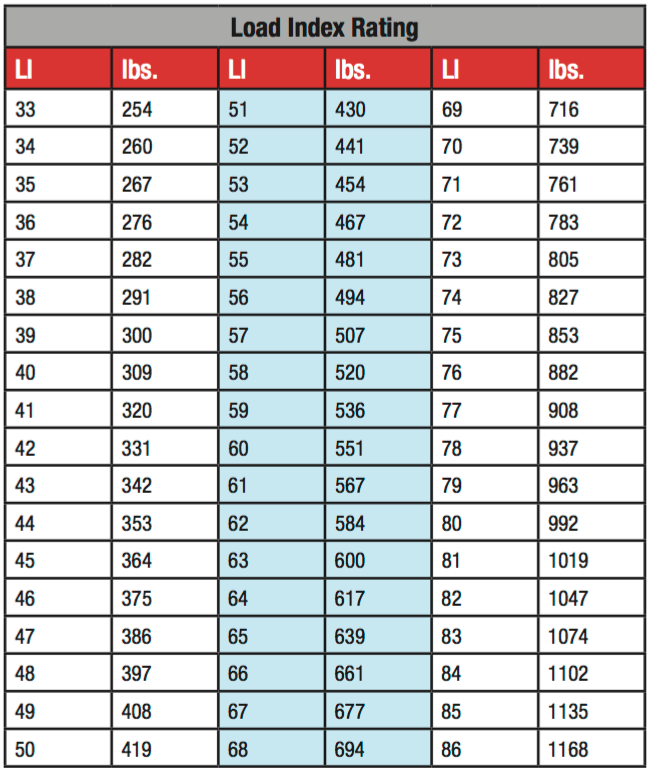 The best solution for calculating the load index is the recommendations of the car manufacturer, indicated in its technical documentation.
The best solution for calculating the load index is the recommendations of the car manufacturer, indicated in its technical documentation.
Below is a complete table of indexes (coefficients) of load capacity :
| LI | kg | LI | kg | LI | kg | LI | kg | LI | kg | LI | kg | LI | kg |
|---|---|---|---|---|---|---|---|---|---|---|---|---|---|
| 0 | 45 | 40 | 140 | 80 | 450 | 120 | 1400 | 160 | 4500 | 200 | 14000 | 240 | 45000 |
| one | 46.2 | 41 | 145 | 81 | 462 | 121 | 1450 | 161 | 4625 | 201 | 14500 | 241 | 46250 |
| 2 | 47. 5 5 | 42 | 150 | 82 | 475 | 122 | 1500 | 162 | 4750 | 202 | 15000 | 242 | 47500 |
| 3 | 48.7 | 43 | 155 | 83 | 487 | 123 | 1550 | 163 | 4875 | 203 | 15500 | 243 | 48750 |
| four | fifty | 44 | 160 | 84 | 500 | 124 | 1600 | 164 | 5000 | 204 | 16000 | 244 | 50000 |
| 5 | 51.5 | 45 | 165 | 85 | 515 | 125 | 1650 | 165 | 5150 | 205 | 16500 | 245 | 51500 |
| 6 | 53 | 46 | 170 | 86 | 530 | 126 | 1700 | 166 | 5300 | 206 | 17000 | 246 | 53000 |
| 7 | 54.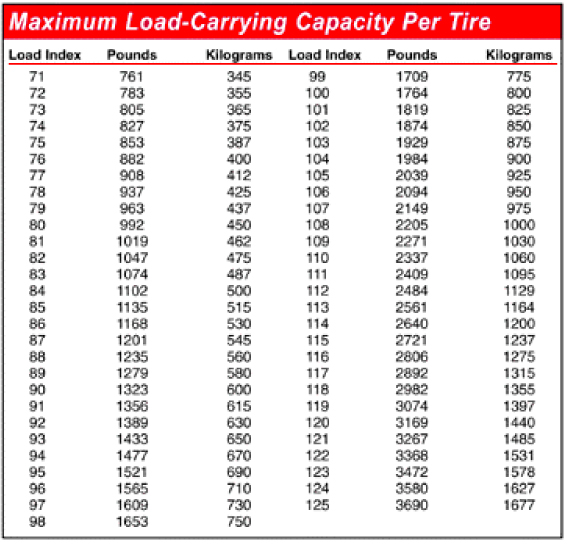 5 5 | 47 | 175 | 87 | 545 | 127 | 1750 | 167 | 5450 | 207 | 17500 | 247 | 54500 |
| eight | 56 | 48 | 180 | 88 | 560 | 128 | 1800 | 168 | 5600 | 208 | 18000 | 248 | 56000 |
| 9 | 58 | 49 | 185 | 89 | 580 | 129 | 1850 | 169 | 5800 | 209 | 18500 | 249 | 58000 |
| ten | 60 | fifty | 190 | 90 | 600 | 130 | 1900 | 170 | 6000 | 210 | 19000 | 250 | 60000 |
| eleven | 61. 5 5 | 51 | 195 | 9one | 615 | 131 | 1950 | 171 | 6150 | 211 | 19500 | 251 | 61500 |
| 12 | 63 | 52 | 200 | 92 | 630 | 132 | 2000 | 172 | 6300 | 212 | 20000 | 252 | 63000 |
| 13 | 65 | 53 | 206 | 93 | 650 | 133 | 2060 | 173 | 6500 | 213 | 20600 | 253 | 65000 |
| fourteen | 67 | 54 | 212 | 94 | 670 | 134 | 2120 | 174 | 6700 | 214 | 21200 | 254 | 67000 |
| fifteen | 69 | 55 | 218 | 95 | 690 | 135 | 2180 | 175 | 6900 | 215 | 21800 | 255 | 69000 |
| 16 | 71 | 56 | 224 | 96 | 710 | 136 | 2240 | 176 | 7100 | 216 | 22400 | 256 | 71000 |
| 17 | 73 | 57 | 230 | 97 | 730 | 137 | 2300 | 177 | 7300 | 217 | 23000 | 257 | 73000 |
| eighteen | 75 | 58 | 236 | 98 | 750 | 138 | 2360 | 178 | 7500 | 218 | 23600 | 258 | 75000 |
| 19 | 77. 5 5 | 59 | 243 | 99 | 775 | 139 | 2430 | 179 | 7750 | 219 | 24300 | 259 | 77500 |
| twenty | 80 | 60 | 250 | 100 | 800 | 140 | 2500 | 180 | 8000 | 220 | 25000 | 260 | 80000 |
| 21 | 82.5 | 61 | 257 | 101 | 825 | 141 | 2575 | 181 | 8250 | 221 | 25750 | 261 | 82500 |
| 22 | 86 | 62 | 265 | 102 | 850 | 142 | 2650 | 182 | 8500 | 222 | 26500 | 262 | 85000 |
| 23 | 87. 5 5 | 63 | 272 | 103 | 875 | 143 | 2725 | 183 | 8750 | 223 | 27250 | 263 | 87500 |
| 24 | 90 | 64 | 280 | 104 | 900 | 144 | 2800 | 184 | 9000 | 224 | 28000 | 264 | |
| 25 | 92.5 | 65 | 290 | 105 | 925 | 145 | 2900 | 185 | 9250 | 225 | 29000 | 265 | 92500 |
| 26 | 95 | 66 | 300 | 106 | 950 | 146 | 3000 | 186 | 9500 | 226 | 30000 | 266 | 97500 |
| 27 | 97. |